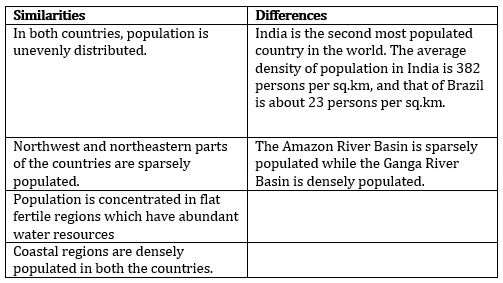Class 10 MAHARASHTRA STATE TEXTBOOK BUREAU Solutions Social Studies Chapter 6 - Population
Population Exercise 45
Solution 1(a)
Right
Solution 1 (b)
Right
Solution 1 (c)
Wrong. Due to developed medical and healthcare facilities, the life expectancy of Indians is increasing.
Solution 1 (d)
Wrong. The north-western part of India is sparsely populated.
Solution 1 (e)
Wrong. The western part of Brazil is less populated.
Solution 2 (a)
Descending order: Uttar Pradesh, Madhya Pradesh, Andhra Pradesh, Himachal Pradesh, Arunachal Pradesh
Solution 2 (b)
Ascending order of population:
Amazonas, Alaguas, Parana, Sao Paulo, Rio de Janeiro
Solution 2 (c)

Solution 3(a)

Solution 3 (b)
Correlation between climate and population distribution:
- There is a close relation between climate and population distribution.
- Dense population is found in areas with moderate climatic conditions and moderate rainfall. Example- coastal plains of Brazil and the Northern Indian Plains.
- Regions with extreme climatic conditions are sparsely populated. For example, north-western and the Himalayan regions in the country are sparsely populated.
Solution 4 (a)
The qualitative aspects of a population are important for a nation's economic and social progress. It is the people who with the help of their skills and productivity add value to a resource.
Solution 4 (b)
According to 2010 census, Brazil is the fifth largest country in the world with respect to area and has a population of about 19 crores. It occupies 5.6% of world's total land area and accounts for only 2.78% of the world's total population.
Thus, Brazil occupies more percent of world's land and less percent of world's total population. Therefore, the density of population is very less in Brazil, i.e., around 23 persons per sq.km
Solution 4 (c)
- India is the second most populous country in the world, with a population of about 121 crores according to the Census of 2011.
- It occupies only 2.41% of the land area of the world but supports 17.5% of the world's population.
- Its richness in natural resources makes it densely populated.
Solution 4 (d)
The interior part of the Amazon Basin has a very hot and humid climate. It receives heavy rainfall of nearly 2000 mm and has dense inaccessible forests. As a result, transportation, agriculture and industries are not well developed here. Hence, the density of population is sparse in the Amazon Basin.
Solution 4 (e)
The Gangetic Plains have been formed due to the depositional activities of the Himalayan rivers. Thus, these are very fertile and support agriculture. Moderate rainfall, fertile land, proximity to the Himalayan rivers and flat plains have made it densely populated.
Solution 5
- The density of population in fig A is 7 persons /sq km. Hence it is sparsely populated. In fig B, the density of population is 18 persons/sq km. Hence it is densely populated.
- One sign represents 100 persons. There are 10 female signs, there are,
10X100=1000 females
Since there are 8 males signs, there are
8X100=800 males. If the number of males is 1000, then the number of females=?
Sex ratio: 1000X1000/800= 1250.
The sex ratio is favourable in this case.
Solution 6
- The northern Indian Plains and the southern states are densely populated.
- The central, western and northeastern states like Assam are moderately populated.
- The states like Jammu and Kashmir and Arunanchal Pradesh are least populated.

